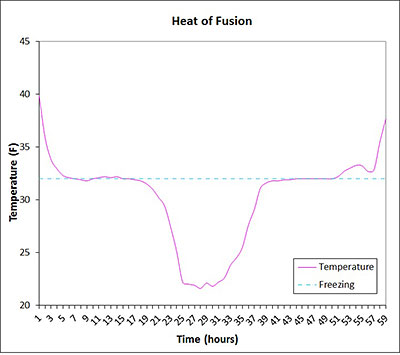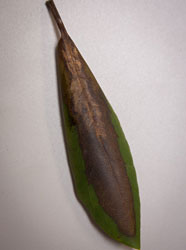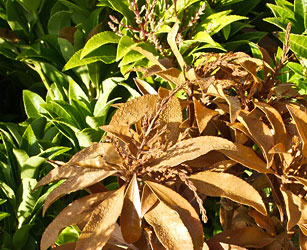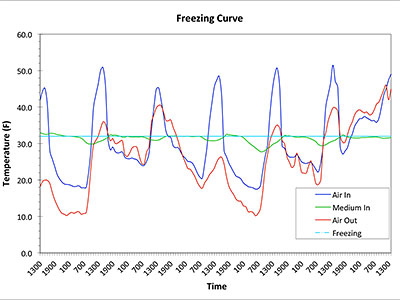Fact Sheet FS528
Introduction
Temperate climate woody plant material requires a dormant period of colder temperatures to perform well the following season. Typically, six to eight weeks of temperatures below 40°F is needed. For herbaceous perennials a process called "vernalization" (cool temperature exposure) is needed for them to flower, usually along with a dormant period.
While the primary concern for nursery plant material grown in soil is damage to the foliage, crown or stems, growers of plant material produced in containers must also be concerned about root viability. The ability of plants to adapt to cold is determined by their genetic makeup. Two factors that allow plants to acclimate (increase the plant's ability to withstand colder conditions) are decreasing day length and colder temperatures. Factors that can reduce the plant's capacity to acclimate include high fertility and physiological damage during the period of acclimation along with elevated and typically fluctuating temperatures during the normally cold winter season. Maintaining adequate media moisture throughout the winter is the single most important factor to reduce root damage.
Development of Cold Hardiness
Woody plant material: Acclimation to cold temperatures in the above ground portion of plants is initiated by shorter days followed by lower and then freezing temperatures. To become fully hardy, nursery crops require exposure to temperatures from 32°F to 40°F (0.0°C to 7.2°C) followed by temperatures slightly below freezing. While colder temperatures slow or stop root growth, they don't acclimate to the same extent as shoots. The day length doesn't seem to impact the development of hardiness in roots. Root hardiness is the most important factor affecting the winter survival of container-grown ornamentals. The temperature of growing media is the factor that determines the tolerance of a plant to different temperatures. Table 1 presents information on the root hardiness of various woody plants.

Chart 1.
Low air temperatures significantly influence the performance of plant material when grown in containers. The primary factor that buffers the effects of low air temperature is water in the medium. Under freezing temperature conditions, the heat of fusion (the heat energy that needs to be given up in order for water to freeze) protects plant roots. It requires the loss of 79.7 calories of energy/gram to change water to ice. The media temperature will remain in the range of 28° to 32°F while it freezes (Chart 1). In comparison, it takes 100 calories or energy/gram of water to raise the temperature from 0°F to 212°F (0°C to 100°C). Following the loss of the heat of fusion, medium temperatures will drop to near ambient air temperatures.
Herbaceous plant material: There has been relatively little research conducted relating to cold hardiness of herbaceous perennials. Since the aerial portions of the plants die back during the winter, the areas of concern are for the crown and roots of the plants. Concern is also primarily directed at container produced nursery stock since in-ground material is largely buffered from the effects of cold due to soil mass. As with woody plant material grown in containers, roots are exposed to near-ambient air temperatures after being exposed to freezing temperatures for an extended period of time.
Research has been done on herbaceous perennial cold acclimation. The strongest relationship to survival was that having a well-developed root system helps plants survive better than a weak one. Work on the factor of plant age to survival and quality indicated it was not related. Based on information presented in Table 2, herbaceous perennials, in general, do not exhibit the same level of hardiness as woody plant material.

Internal flooding on boxwood.

Internal flooding on rhododendron.

Chilling damage on Pieris.
Types of Cold Weather Plant Injury
Under colder conditions, root hardiness is of primary concern when overwintering container plant material. With milder winter conditions, foliar and crown damage becomes increasingly possible. Cultural practices that stimulate late season growth can impact a plant's ability to acclimate and should be avoided. Symptoms for most of the following types of damage will not show up until the plant becomes more physiologically active.
Stem dieback
- Dieback of plant stems is usually related to problems resulting from growth that has not hardened off in the fall although extreme cold can cause tissue damage and subsequent dieback.
- Damage can also occur in the spring when buds have de-hardened and growth initiated followed by freezing temperatures. The later in the spring that a freeze occurs results in an increased probability of damage.
Foliar injury
- Marginal necrosis: leaf edge dieback of evergreen plants
- These problems are related to leaves that are not fully hardy or lack of water in the leaves. Frozen media combined with low humidity will cause damage from lack of water
- Secondary infection from Botrytis causes the gray appearance on leaves
- Chilling damage
- Chilling is usually a problem after leaves have fully lost their hardiness and are ready for spring growth
- Symptoms are a bleaching of the foliage that will be followed by browning
- Internal flooding of leaves
- Fleshy leaves seem to be most susceptible (rhododendron, boxwood)
- Leaves accumulate water due to warm media but don't release it due to high humidity. Subsequent freezing delaminates the leaf, usually expanding from the leaf midrib. As the leaves become more physiologically active, browning occurs.
Crown injury
- The crown is a unique part of the plant, being the juncture between the stem and the root system. It tends to lose hardiness along with the stem but is physiologically active earlier than the stem, thus making it more susceptible to cold damage.
- Bark splitting is less likely on container plant material than those in the field because of the protection afforded by the storage structures. The white poly and the air mass buffer temperatures as they drop. That being said, it can still occur because of the earlier physiological activity of plants kept in a storage facility that is warmer than outside conditions.
On cold, clear days, late afternoon sunlight can cause the stem or trunk of plants to be warm and active. The temperature drop that occurs a short time after sunset can cause the fluids in the vascular tissue to freeze and expand, thus separating the bark from the wood at the cambium. Cold snaps early in the fall or late in the spring when plant are not acclimated to cold can also cause bark splitting.
Bud damage
- The timing of bud swell and bud break is dependent on the type of plant. For those buds that are physiologically active early or those caught by a freeze, damage can occur. Flowers in the bud stage seem to be damaged at higher temperatures than leaf material.
- There are usually no physical signs of damage immediately following injury. Browning occurs as metabolic activity resumes. Under warm conditions, a clean cut across the bud enables one to see if there is browning inside the bud within a few days of the damage event.
Root injury
- Roots of plant can be segregated into categories: primary, secondary and tertiary. Primary roots are the youngest roots while the tertiary are the most mature. Secondary roots are those intermediate in size and are the most critical for survival.
- The phenotypic (appearance) response of roots to physical damage is wood browning. Care must be taken to recognize the "normal" appearance of roots on the specific type of plant being evaluated since it can be quite variable.
- Young roots are the first to be injured by cold temperatures because they are located predominantly at the outside edge of the container and more likely to freeze. Cold injury to young roots can result in little to some reduction in growth of the plant in spring. Uptake of nutrients will be restricted but, depending on the amount of damage, but regeneration may be quick.
- Survival of the secondary roots is critical to the survival of the plant. Growth is almost always reduced in the spring but regeneration may occur if the damage is not severe. Many times, plants with significant damage to secondary roots will appear to grow normally in the spring but die quickly under the first period of elevated temperature, high sunlight and low humidity conditions.
- Damage to tertiary roots almost always results in death of the plant.
Factors Affecting Cold Hardiness
Timing is everything when it comes to nursery crop protection from cold damage.
- A sudden drop to sub-freezing temperatures early in the fall has a higher potential to cause plant damage, especially foliar, than the same drop later in the fall.
- Warm temperatures that extend well into the fall can result in plant damage, both foliar, bud, crown and root, when an extended period of cold follows.
- An extended period of sub-freezing weather in the winter has a greater potential for root damage than periods where sub-freezing nights are alternated with cool, but not freezing days.
- A prolonged "January thaw" can de-acclimate plants and expose them to increased damage following a subsequent period of sub-freezing temperatures.
Management of Over-wintering Structures

Chart 2.
When compared to the outdoor temperature, white (milky) polyethylene covered overwintering structures result in decreased high temperatures and higher low temperatures, effectively offering protection to plants. Chart 2 shows actual temperature data from outside and inside a structure. The following are management suggestions to reduce the probability of cold damage.
- Avoid covering overwintering structures until plants have fully ceased growth unless a period of extreme cold is expected.
- Be sure deciduous plants have dropped leaves
- Be sure evergreen plants have fully stopped growth but cover prior to excessive cold.
- Plants need to be adequately watered when overwintering structures are covered since irrigation systems will need to be shut down and winterized.
- If there are periods when elevated temperatures have dried out the media, plan to irrigate to container capacity prior to the next cold period and flush the water mains to prevent possible damage.
- Avoid placing plants too close to each other while in storage. As temperatures increase resulting in warm media, water will flow into the leaves. When humid conditions that exist in overwintering structures are followed by a sudden cold snap, water accumulated in the leaves (internal flooding) can freeze and cause physiological damage to the plant.
- Flushes of growth that occur late in the season may not harden successfully before winter.
- Avoid application of nitrogen fertilizers late in the season.
- Avoid late season pruning to reduce late-season flushes of growth.
- Attempt to maintain plant growth throughout the growing season. If plant growth ceases late in the season due to environmental conditions, buds may break and grow into the fall. That may reduce the opportunity for plants to acclimate.
- Protect plants from low humidity, wind and direct sunlight to avoid desiccation. Hardened plants can be protected in translucent white (milky-colored) plastic covered structures.
- Keep doors closed under freezing conditions.
- Be sure to ventilate as temperatures rise above reezing unless an extended cold period is in progress. Wait until temperatures have reached 39°F (4°C) in the overwintering structures under those conditions.
- In areas that experience more consistent cold and snow cover, containers are sometimes overwintered by placing pots on their sides, protecting them with straw and/or sheet foam and then covering everything with white polyethylene.
- The preferred location would also be shady.
- It is necessary to control rodents that tend to overwinter and feed underneath the covering.
- Plants de-harden as the day length gets longer and temperatures higher.
- As spring temperatures rise, holes are partially cut in the walls of overwintering structure covers to help reduce the temperature in the structure, leaving the flaps. The flaps can be re-sealed if temperatures drop to potentially plant damaging levels.
- One must consider weather forecasts prior to removing polyethylene from the overwintering structures. Plants that experience freezing temperatures late in the spring are easily damaged. There have been years when growers have had to recover to protect plants.
- When conditions arise where overwintering structures are uncovered and freezing temperatures occur,
- Start irrigating plants when temperatures drop near 32°F.
- Continue irrigating until all ice has melted off the plants being protected (the heat of fusion discussed earlier will help to protect plants).
- Recognize that if sub-freezing temperatures persist for extended periods there may be significant structural damage to the plants causing breakage of stems from the weight of ice.
- Also realize that irrigation may not fully protect plants during periods of extreme cold.
References
| Highest temperature that killed more than 50% of root system and reduced top growth | |||
|---|---|---|---|
| Scientific Name | Common Name | °F | °C |
| Magnolia soulangiana | Saucer Magnolia | 23 | -5.0 |
| Magnolia stellata | Star Magnolia | 23 | -5.0 |
| Cornus florida | Flowering Dogwood | 20 | -6.7 |
| Daphne cneorum | Garland Flower | 20 | -6.7 |
| Ilex crenata 'Convexa' | Convex Japanese Holly | 20 | -6.7 |
| Ilex crenata 'Hetzi' | Hetz Japanese Holly | 20 | -6.7 |
| Ilex crenata 'Stokesii' | Stokes Japanese Holly | 20 | -6.7 |
| Ilex opaca | American Holly | 20 | -6.7 |
| Pyracantha coccinea | Fire Thorn | 18 | -7.8 |
| Cryptomeria japonica | Japanese Cedar | 16 | -8.9 |
| Cotoneaster horizontalis | Rock Cotoneaster | 15 | -9.4 |
| Viburnum carlesii | Korean Spice Viburnum | 15 | -9.4 |
| Cytisus praecox | Warminster broom | 15 | -9.4 |
| Buxus sempervirens | Common Boxwood | 15 | -9.4 |
| Ilex glabra | Inkberry Holly | 15 | -9.4 |
| Euonymus fortunei 'Carrierei' | Carrier Euonymus | 15 | -9.4 |
| Euonymus fortunei 'Argenteo-marginata' | Variegated Euonymus | 15 | -9.4 |
| Hedera helix 'Baltica' | Baltic Ivy | 15 | -9.4 |
| Pachysandra terminalis | Japanese pachysandra | 15 | -9.4 |
| Vinca minor | Common Periwinkle | 15 | -9.4 |
| Pieris japonica 'Compacta' | Compact Pieris | 15 | -9.4 |
| Acer palmatum 'Atropurpureum' | Bloodleaf Japanese Maple | 14 | -10.0 |
| Cotoneater adpressa praecox | Nan-Shan Cotoneaster | 10 | -12.2 |
| Taxus x media 'Nigra' | Nigra Yew | 10 | -12.2 |
| Rhododendron 'Gibraltar' | Gibraltar Azalea | 10 | -12.2 |
| Rhododendron 'Hinodegiri' | Azalea hybrid | 10 | -12.2 |
| Pieris japonica | Japanese Pieris | 10 | -12.2 |
| Leucothoe fontanesiana | Drooping Leucothoe | 5 | -15.0 |
| Pieris floribunda | Flowering Pieris | 5 | -15.0 |
| Euonymus fortunei 'Colorata' | Purple Leaf Wintercreeper | 5 | -15.0 |
| Juniperus horizontalis | Creeping Juniper | 0 | -17.8 |
| Juniperus horizontalis 'Douglasii' | Waukegan Juniper | 0 | -17.8 |
| Rhododendron carolinianum | Carolina Rhododendron | 0 | -17.8 |
| Rhododendron catawbiense | Catawba Rhododendron | -10 | -23.3 |
| Rhododendron P.J.M. hybrids | P.J.M. Rhododendron | -10 | -23.3 |
| Potentilla fruticosa | Shrubby Cinquefoil | -10 | -23.3 |
| Picea glauca | White Spruce | -10 | -23.3 |
| Picea omorika | Serbian Spruce | -10 | -23.3 |
Source: Havis, J.R. 1964. Root hardiness of woody ornamentals. HortScience 11(4):385-386.
| Growing medium temperature causing significant injury (Unsalable, unacceptable regrowth) | |||
|---|---|---|---|
| Scientific Name | Common Name | °F | °C |
| Tender | |||
| Aster lateriflorus var. horizontalis | Calico Aster | 28 | -2.2 |
| Digitalis x mertonensis | Strawberry Foxglove | 24 | -4.4 |
| Geum quellyon 'Mrs. Bradshaw' | Chilean Avens | 24 | -4.4 |
| Hibiscus moscheutos 'Disco Belle Hybrids' | Disco Belle Hibiscus | >38 | >3.3 |
| Houttuynia cordata 'Chameleon' | Chameleon Plant | 28 | -2.2 |
| Kniphofia uvaria 'Pfitzei' | Torchlily | 27 | -2.8 |
| Polystichum tsussimense | Korean Rock Fern | > 38 | >3.3 |
| Thelyptris kunthii | Kunth's Maiden Fern | 28 | -2.2 |
| Tricyrtis formosana 'Amethystina' | Japanese Toad Lily | 28 | -2.2 |
| Intermediately Hardy | |||
| Astilbe x arendsii 'White Gloria' | False Spirea | 15 | -9.4 |
| Campanula glomerata var. acaulis | Clustered Bellflower | 15 | -9.4 |
| Caryopteris x clandonensis 'Longwood Blue' | Bluebeard | 21 | -6.1 |
| Chrysanthemum coccineum | Painted Daisy | 21 | -6.1 |
| Coreopsis grandiflora 'Sunray' | Tickseed | 18 | -7.8 |
| Dendranthema x grandiflora 'Emily' | Garden Chrysanthemum | > 10 | >-12.2 |
| Dendranthema x grandiflora 'Megan' | Garden Chrysanthemum | > 10 | >-12.2 |
| Dendranthema x grnadiflora 'Ruby Mound' | Garden Chrysanthemum | > 10 | >-12.2 |
| Dendranthema x grandiflora 'Triumph' | Garden Chrysanthemum | > 10 | >-12.2 |
| Erodium x variabile 'Roseum' | Heron's Bill | 18 | -7.8 |
| Erysimum hieraclifolium | Wallflower | 21 | -6.1 |
| Gaillardia x grandiflora 'Goblin' | Goblin Blanket Flower | 14 | -10.0 |
| Hebe macrocarpa 'Margret' | Hebe 'Margret' | 18 | -7.8 |
| Hemerocallis 'Joan Senior' | Daylily | 15 | -9.4 |
| Heuchera sanguinea 'Chatterbox' | Coral Bells | 14 | -10.0 |
| Leucanthemum x superbum 'Alaska' | Shasta Daisy | 15 | -9.4 |
| Phlox paniculata 'David' | Garden Phlox | 21 | -6.1 |
| Tiarella cordifolia var. collina 'Dunvegan' | Heartleaf Foamflower | 15 | -9.4 |
| Tiarella cordifolia var. collina 'Oakleaf' | Heartleaf Foamflower | 21 | -6.1 |
| Tricyrtis hirta 'Miyazaki' | Toad Lily | 21 | -6.1 |
| Verbena canadensis 'Homestead Purple' | 'Homestead Purple' Verbena | 18 | -7.8 |
| Veronica 'Sunny Border Blue' | Speedwell | 21 | -6.1 |
| Hardy Perennials | |||
| Achillea 'Coronation Gold' | Yarrow, Sneezewort | 8 | -13.3 |
| Achillea filipendulina 'Parker's Variety' | Fernleaf Yarrow | 12 | -11.1 |
| Campanula takesimana | Korean Bellflower | 2 | -11.1 |
| Dendranthema x grandiflora 'Baby Tears' | Garden Chrysanthemum | <10 | <-12.2 |
| Dendranthema x grandiflora 'Debonair' | Garden Chrysanthemum | <10 | <-12.2 |
| Gaillardia x grandiflora 'Monarch Group' | Monarch Blanket Flower | 12 | -11.1 |
| Heuchera americana 'Dale's Strain' | Coral Bells | 12 | -11.1 |
| Hylotelephium (Sedum) spectabile 'Brilliant' | Showy Stonecrop | -6 | -21.1 |
| Lythrum salicaria 'Robert' | Purple Loosestrife | 12 | -11.1 |
| Monarda 'Marshall's Delight' | Bee Balm | 8 | 13.3 |
| Penstemon fruticosus 'Purple Haze' | Shrubby Penstemon | 12 | -11.1 |
| Phlox divaricata subsp. Laphamii 'Chattahoochee' | Wild Sweet William | 7 | -13.9 |
| Phlox glaberrima 'Morris Berd' | Smooth Phlox | 7 | -13.9 |
| Phlox paniculata 'White Admiral' | Garden Phlox | 8 | -13.3 |
| Physostegia virginiana 'Summer Snow' | Obedient Plant, False Dragonhead | 7 | -13.9 |
| Rosmarinus officinalis 'Arp' | Rosemary | 12 | -11.1 |
| Salvia x superba 'Stratford Blue' | Hybrid Sage | 10 | -12.2 |
| Sedum 'Autumn Joy' | Stonecrop | -11 | -23.9 |
| Tanacetum coccineum 'Robinson's Mix' | Pyrethrum Daisy | 10 | -12.2 |
| Tiarella cordifolia var. collina 'Slick Rock' | Heartleaf Foamflower | 12 | -11.1 |
| Tiarella cordifolia var. collina 'Laird of Skye' | Heartleaf Foamflower | 8 | -13.3 |
| Tiarella cordifolia 'Running Tapestry' | Heartleaf Foamflower | 12 | -11.1 |
| Veronica repens | Speedwell | 7 | -13.9 |
Source: Perry, L. P. 1998. Herbaceous Perennials Production: A Guide from Propagation to Marketing. NRAES-93. pp 56.
February 2015
Copyright © 2024 Rutgers, The State University of New Jersey. All rights reserved.
For more information: njaes.rutgers.edu.
Cooperating Agencies: Rutgers, The State University of New Jersey, U.S. Department of Agriculture, and Boards of County Commissioners. Rutgers Cooperative Extension, a unit of the Rutgers New Jersey Agricultural Experiment Station, is an equal opportunity program provider and employer.

